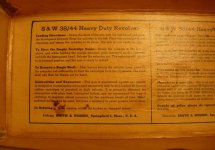Many posters here, including myself, have stated that the use of jacketed bullets in old (pre WW II) S&W revolvers tend to be hard on the barrels, as these were built from milder steel.
In another thread, the image of the instructions, found inside of the box lid, for the early revolvers was posted. The last line of those instructions read thusly:
"Experience shows that metal patched bullets are frequently responsible for barrel troubles." Click on the link below and look at post #5.
http://smith-wessonforum.com/s-w-ha...20-hand-ejector-4th-change.html#post140366636
The box has this printed inside of it "This Container Patented Dec. 28, 1920"
In another thread, the image of the instructions, found inside of the box lid, for the early revolvers was posted. The last line of those instructions read thusly:
"Experience shows that metal patched bullets are frequently responsible for barrel troubles." Click on the link below and look at post #5.
http://smith-wessonforum.com/s-w-ha...20-hand-ejector-4th-change.html#post140366636
The box has this printed inside of it "This Container Patented Dec. 28, 1920"
Last edited:

